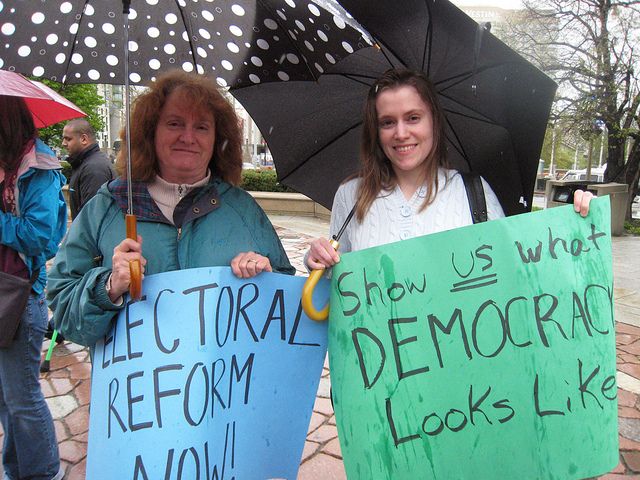Pre-electoral coalitions increase voter turnout by making elections more decisive
The UK continues to use the First Past the Post electoral system, which is more likely to result in majority governments, but less representative of voter preferences as expressed through the ballot box. It has been argued that not only are proportional systems fairer than majoritarian ones, but that they can increase turnout through making votes more consequential. Here Erik R. Tillman argues that pre-electoral coalitions can also increase turnout by providing voters with a decisive outcome.
In his 1996 presidential address to the American Political Science Association, Arend Lijphart described unequal levels of political participation as “democracy’s unresolved dilemma.” Drawing on the academic literature on voter participation, Lijphart recommended that one solution is to encourage states to adopt proportional representation (PR) electoral rules, which “stimulate voter participation by giving the voters more choices and by eliminating the problem of wasted votes.”
The argument that PR rules stimulate turnout has strong support in political science research. PR increases turnout compared to single-member district (SMD) systems in two ways. First, PR systems have low barriers to entry for small parties. While parties in PR systems may gain seats in parliament with as little as 3-5% of the national vote, parties in SMD systems must win much larger shares to have a chance of winning seats. SMD systems create strategic incentives for voters and politicians to coalesce around larger parties, resulting in fewer electoral options for voters.
As a result, many voters in SMD systems who would prefer to vote for a smaller but unviable party may end up not participating if they sense that their vote would be “wasted.” This problem is minimised under PR rules, giving supporters of smaller parties more incentive to vote. Second, PR systems do not have the problem of uncompetitive districts. In SMD systems, there are typically a large number of uncompetitive districts in which there is less incentive for parties to mobilise voters and for voters to participate. In PR systems, there is a greater incentive for parties to mobilise voters in all districts. A recent study suggests that reduced turnout in uncompetitive districts accounts for most of the turnout gap between PR and SMD systems.
The finding that PR increases turnout is contrasted by an equally compelling result that multiparty systems decrease turnout. We believe that multiparty systems reduce turnout by making elections less decisive to voters. First, multiparty systems are less likely to produce single-party governments, meaning that elections are followed by a period of coalition bargaining. If voters cannot anticipate the outcome of these negotiations, then they may be less likely to vote. Second, coalition (and minority) governments diffuse responsibility for policy outcomes, meaning that voters may be less certain about how to vote if they wish to sanction the incumbent government. Through both mechanisms, multiparty systems reduce turnout by making elections less decisive to voters.
These contrasting findings are puzzling, because PR typically facilitates multiparty systems. In effect, PR may directly stimulate turnout while also indirectly decreasing turnout through its effect on the party system. Because of the relationship between electoral rules and the party system, it can be difficult to isolate the effect of each on turnout.
To shed light on this puzzle, I exploit the natural variation in the existence of pre-electoral coalitions (PEC). A PEC is a public agreement between two or more parties not to compete independently in an election with the goal of governing together after the election. PECs provide credible signals to voters about the parties’ intentions, and they help to clarify the possible outcomes of the election. In effect, a PEC signals to voters that its parties will form the government if they have sufficient parliamentary strength.
When parties form PECs, they create a more decisive environment in that election without changing the underlying features of the electoral system or other institutions. If the respective arguments about the effects of PR and multiparty systems on voter participation are correct, then the presence of a PEC should mitigate the turnout-reducing effect of multiparty systems without weakening the turnout-stimulating effect of the PR system. That is because the participants in a PEC normally remain independent parties. Voters do not face reduced electoral choice, and each party still has an incentive to mobilise voters nationally. However, the presence of the PEC clarifies the potential post-election coalition outcomes to voters. All else equal, turnout should be higher in elections with PECs than in elections without them.
To test this prediction, I built upon the extensive data on PECs collected by Sona Golder to generate a data set containing 223 national parliamentary elections in 19 advanced democracies between 1970 and 2011. Using a fixed-effects regression design that focuses on the effect of PECs on turnout change within each country, I found that the presence of a PEC is associated with an average turnout increase of over 1.5 percentage points (gated, ungated). Limiting the analysis to only large PECs (those with cumulative vote shares over 20%) suggests an increase in turnout of closer to 2.2 percentage points. This finding is consistent with the argument that the presence of a PEC made the election more decisive to voters.
What do these findings mean for those interested in promoting higher turnout? PECs results from strategic behavior by parties, so there would be no reasonable way to mandate their formation. Thus, one cannot propose PECs as a “solution” to the problem of low turnout. However, this study fits with a broader set of findings on turnout that highlight the competitive dynamic of the election.
Generally, citizens are more likely to participate in elections when they offer meaningful choices and clear potential outcomes. Proposed electoral reforms often seek to stimulate turnout by making the act of voting easier. Though this study’s results do not challenge the value of that goal, they suggest that it would also be fruitful to focus on ways to make elections more meaningful to voters as a mechanism to sanction incumbents and select future governments.
—
This post represents the views of the author only, and not those of Democratic Audit UK, the LSE Public Policy Group, or the LSE. Please read our comments policy before posting.
—
Erik Tillman is Associate Professor in Political Science at Depaul University’s School of Liberal Arts and Social Science in Chicago. His full academic profile can be found here.







 Democratic Audit's core funding is provided by the Joseph Rowntree Charitable Trust. Additional funding is provided by the London School of Economics.
Democratic Audit's core funding is provided by the Joseph Rowntree Charitable Trust. Additional funding is provided by the London School of Economics.
Preelectoral coalitions can increase turnout by providing voters with decisive outcome. Interesting piece @ertillman https://t.co/1FY321MLWj
Pre-electoral coalitions increase voter #turnout by making elections more decisive, writes @ertillman https://t.co/CRhfONW3hi #FPTP
Pre-electoral coalitions increase voter turnout by simplifying choices & making elections more decisive https://t.co/3Y3rbhcZ0H
[…] Election rules. Election Data. Uk Postal Votes. Uk election fraud. UK Election 2015 Voting. Miscellaneous. Pre-electoral coalitions increase voter turnout by making elections more decisive. […]
“Pre-electoral coalitions increase voter turnout by making elections more decisive.” My blog at @democraticaudit https://t.co/k46noJemIY
Pre-electoral coalitions increase voter turnout by making elections more decisive https://t.co/3Y3rbhcZ0H
Pre-election coalitions increase turnout by 1.5 percentage points, finds @ertillman in @democraticaudit : https://t.co/KTNhZ5mz78
Pre-electoral coalitions increase voter turnout by making elections more decisive https://t.co/RSqA1riCh2 https://t.co/2OQ2DaW1ch